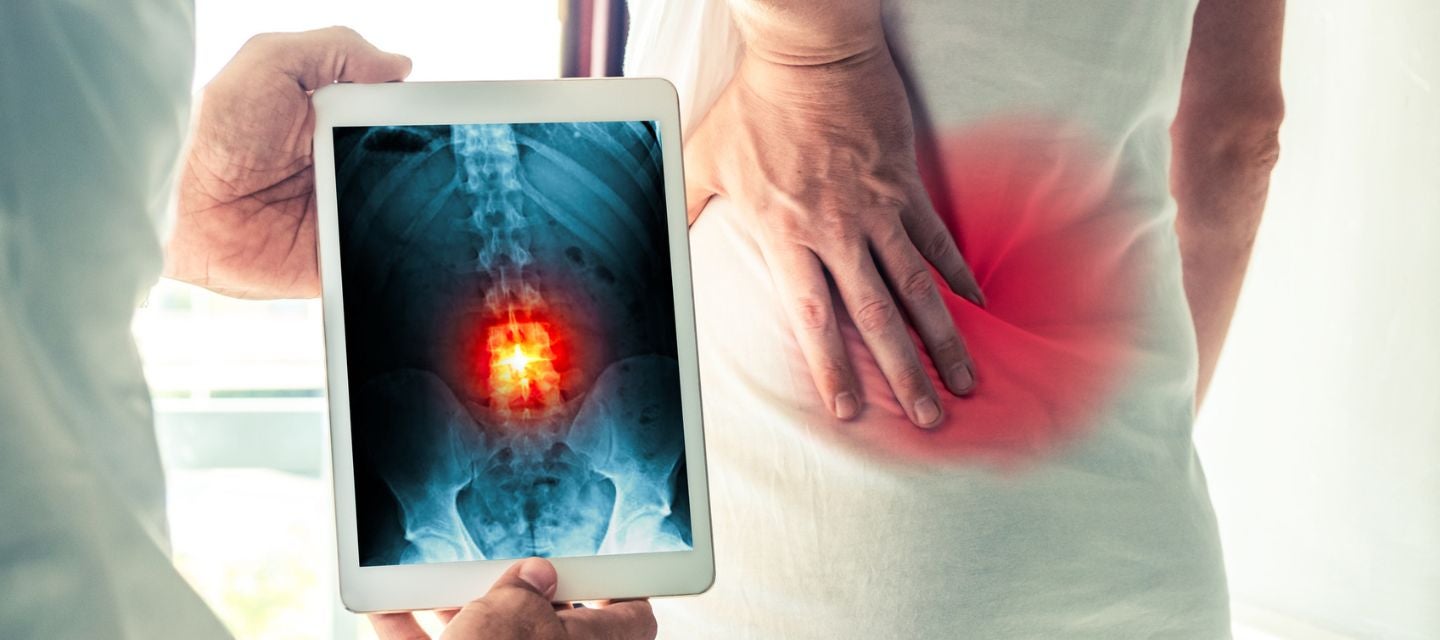
4 July 2022
The most common causes of lower back pain
4 July 2022
The most common causes of lower back pain

Lower back pain is a very common complaint. The Australian Bureau of Statistics estimate that 4 million Australians (16% of the population) have back problems, and that most people will suffer from an episode of lower back pain at some stage in their lives.
Instances of lower back pain can be isolated (acute) or ongoing (Chronic). Back pain can impact heavily upon an individual’s lifestyle, leading to an inability to work and reduced income. Ongoing unresolved back pain is a leading cause of disability globally.
This article explores lower back injuries, including symptoms, causes, risk factors, prevention and diagnostic methods.
Symptoms
Back pain can vary in nature and severity. While the pain may be restricted to the back, some lower back injuries cause shooting or stabbing pain which can radiate through the hips and pelvis, down the leg or through the mid back. Symptoms will sometimes worsen when moving, walking, twisting or bending over.
It’s a good idea to see a doctor if lower back pain is severe or persists for more than a few days when the cause is unknown.
If the pain radiates into the legs or buttocks (known as sciatica), causes weakness, numbness or tingling - especially following an acute injury or fall, then it’s a good idea to ask your doctor whether a scan such as a lumbar spine MRI is appropriate.
Causes
Some of the most common injuries and conditions known to cause lower back pain include:
Soft tissue injury
Muscle and ligament strains can be caused by regular heavy lifting or a one-off awkward movement such as lifting an object while twisting. These sorts of injuries can result in painful muscular spasms or shooting pain.
Intervertebral disc injury
Discs are soft tissue that act as cushions between the vertebrae. When this soft tissue tears or ruptures due to injury, it is known as disc herniation. A bulging or ruptured disc can sometimes be painful, and if large enough they can push onto a nerve causing pain and even loss of function. Intervertebral disc injuries are generally diagnosed via scans of the spine such as a lumbar spine MRI or CT.
Degenerative conditions
Degenerative conditions such as osteoarthritis (affecting the spinal joints), or spondylosis (affecting the intervertebral disc) can affect the lumbar spine, and occasionally result in ongoing pain. Degeneration can result in enlargement of the joints and ligaments and cause narrowing of the spinal canal (called spinal stenosis). Osteoporosis occurs when there is loss of bone (reduced bone density). This can then weaken the bone and cause painful fractures. It is best diagnosed with either a special CT scan or a DEXA machine (Dual-energy X-ray absorptiometry).
Risk factors
Heavy/ Improper lifting: Repetitive heavy lifting or lifting with poor form is one of the most common causes of acute soft tissue and disk injuries. Using your back to lift rather than legs tend to result in most injuries.
Age: According to the Australian Bureau of Statistics, the risk of developing back problems rises significantly for people over age 35. People aged 55-64 experience the highest prevalence of back problems, followed by those aged 65-74 then those aged 75+.
Being overweight: Carrying excess bodyweight puts extra strain on all the body’s joints as well as the spine. Overweight and obese individuals experience higher incidence of lower back pain and back injuries.
Existing conditions/ diseases: Conditions such as arthritis as well as joint issues which affect movement can lead to higher incidences of lower back pain.
Preventing lower back injury
Reducing body weight: Lowering bodyweight will reduce strain on the spine and put less load on the muscles in the lower back. Maintaining a healthy body weight lowers the risk of developing a back injury or condition and can reduce existing lower back pain.
Strength & flexibility: Regular exercise, strength and flexibility training reduces the risk of incurring a back injury or developing a condition that leads to lower back pain. Strengthening the lower back, abdominal and core muscles support the spine and can alleviate pain.
Correct lifting techniques: Learning to lift heavy objects with the legs rather than the back takes strain off the lower back muscles, ligaments and spine. Avoid any twisting movements while lifting and keep heavy objects close to the body while bending the knees.
Posture: Avoid sitting or standing in the same position for long periods of time. Switch positions regularly, avoid slouching the shoulders and maintain a neutral pelvic position. Choose a chair with good support when sitting for extended periods and support the lower spine with a pillow or back support.
Using MRI for diagnosis
An MRI scan of the lumbar spine is one of the most useful tools for evaluating the cause of lower back pain. Doctors may refer patients for a lumbar spine MRI if they experience lower spine or lower back injury, if lower back pain is accompanied by other symptoms, if spinal surgery is scheduled, or to access the spine following surgery.
To obtain a referral for an MRI, or any other medical imaging procedure, you must be clinically assessed by a doctor first. This is so they can evaluate your injury or pain and recommend the best course of action to diagnose the issue.
Why you can trust I-MED Radiology
Our team of content writers create website materials that adhere to the principals set out in content guidelines, to ensure accuracy and fairness for our patients. Dr. Ronald Shnier, our Chief Medical Officer, personally oversees the fact-checking process, drawing from his extensive 30-year experience and specialised training in radiology.
